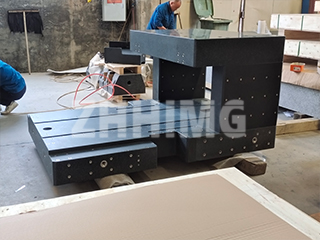A granite measuring platform is a high-precision, flat surface tool made from natural granite. Known for its exceptional stability and low deformation, it serves as a critical reference base in precision measurement, inspection, and quality control applications across industries such as machining, electronics, and metrology.
Its ability to minimize vibration interference makes it an indispensable asset in environments requiring extreme accuracy, such as CMM (coordinate measuring machine) operations, laser scanning, and dimensional tolerance checks.
Purpose and Application
Granite measuring platforms are designed to provide a stable, flat reference surface for high-precision measurement tasks. When combined with instruments like CMMs, optical projectors, or laser measurement systems, these platforms allow for accurate evaluation of part dimensions, geometric tolerances, and assembly precision.
Key Features of Granite Measuring Platforms
1. Superior Dimensional Stability
Granite has a low thermal expansion coefficient, ensuring consistent dimensions even under temperature fluctuations. This makes it ideal for use in environments where thermal drift can impact measurement results.
2. Excellent Wear Resistance
With its high hardness, granite resists wear even under heavy, long-term usage. The platform’s surface maintains flatness and precision in harsh industrial environments.
3. Vibration Damping Capability
One of granite’s unique advantages is its natural ability to absorb vibrations, significantly reducing their impact on measuring accuracy. This ensures stable readings in sensitive operations such as high-resolution scanning or tight-tolerance inspection.
4. Low Water Absorption
Granite has low porosity, meaning minimal water absorption. This helps maintain dimensional integrity in humid environments and prevents swelling or surface distortion.
5. Smooth Surface Finish
Through precision grinding and polishing, the surface of the granite platform becomes smooth and reflective, ensuring excellent contact with the measured parts and improved measurement accuracy.
6. Easy Maintenance
Granite platforms are non-metallic, rust-free, and easy to clean. Simple maintenance—such as wiping with water or neutral detergent—is sufficient to keep them in optimal condition.
Manufacturing Process
1. Material Selection & Cutting
High-quality black granite with minimal impurities and low thermal expansion is selected and cut into appropriately sized blocks based on the required platform dimensions.
2. Rough Machining
The cut granite is roughly shaped using milling machines or lathes to remove irregularities and define the platform’s overall geometry.
3. Precision Grinding
The rough block undergoes fine grinding using specialized abrasive tools (e.g., diamond sand) to achieve the required flatness tolerance and surface finish.
4. Heat Treatment & Stabilization
To eliminate residual stress, granite undergoes thermal stabilization, followed by a cooling phase at room temperature to ensure structural integrity and long-term dimensional stability.
5. Polishing & Calibration
After fine grinding, the surface is polished to a mirror finish and tested for dimensional accuracy using certified instruments to ensure it meets the required precision grade.
6. Surface Protection
A thin protective coating or sealant may be applied to prevent surface damage from environmental exposure during storage or use.
Care and Maintenance Tips
- Regular Cleaning:
Keep the platform free from dust and debris using neutral cleaners. Avoid acidic or alkaline substances to protect the surface finish.
- Avoid Impact:
Prevent collisions with tools or workpieces to avoid dents, scratches, or surface distortion.
- Periodic Recalibration:
Regularly verify platform flatness and accuracy using standard gauges. Regrinding may be needed after long-term usage.
- Store Properly:
When not in use, store the platform in a dry, temperature-controlled environment, away from direct sunlight, moisture, and high heat.
- Moisture & Corrosion Control:
Though granite is naturally resistant, keeping it in low-humidity conditions extends longevity and prevents potential microstructural changes.
Conclusion
The granite measuring platform is a cornerstone of precision engineering, offering unmatched vibration resistance, dimensional stability, and wear performance. It is a foundational tool for industries where micron-level accuracy is critical. With proper selection, installation, and maintenance, granite platforms provide long-lasting reliability and contribute to improved product quality, reduced rework, and optimized inspection processes.
Post time: Aug-01-2025

